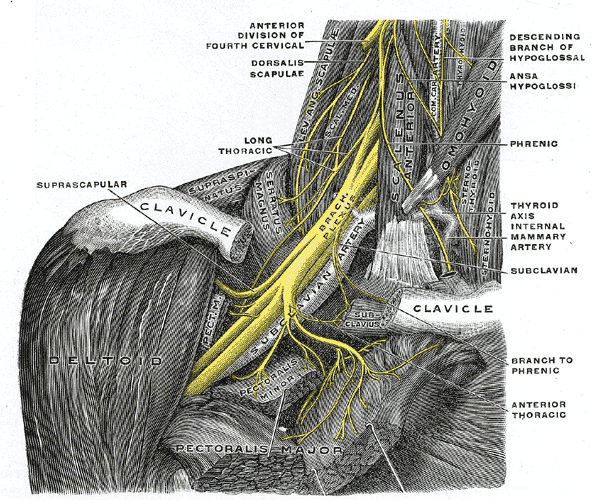Parsonage–turner Syndrome

Parsonage–Turner syndrome, also known as acute brachial neuropathy and neuralgic amyotrophy, is a syndrome of unknown cause; although many specific risk factors have been identified (such as; post-operatively, post-infectious, post-traumatic or post-vaccination), the cause is still unknown. The condition manifests as a rare set of symptoms most likely resulting from autoimmune inflammation of unknown cause of the brachial plexus. (The brachial plexus is a complex network of nerves through which impulses reach the arms, shoulders and chest.)
Parsonage–Turner syndrome occurs in about 1.6 people per 100,000 per year.
Signs and symptoms
This syndrome can begin with severe shoulder or arm pain followed by weakness and numbness. Those who suffer from Parsonage–Turner experience acute, sudden-onset pain radiating from the shoulder to the upper arm. Affected muscles become weak and atrophied, and in advanced cases, paralyzed. Occasionally, there will be no pain and just paralysis, and sometimes just pain, not ending in paralysis. MRI may assist in diagnosis. Scapular winging is commonly seen.
Mechanism
Parsonage-Turner involves neuropathy of the suprascapular nerve in 97% of cases, and variably involves the axillary and subscapular nerves. As such, the muscles usually involved are the supraspinatus and infraspinatus, which are both innervated by the suprascapular nerve. Involvement of the deltoid is more variable, as it is innervated by the axillary nerve.
Diagnosis
Differential diagnosis
The differential focuses on distinguishing it from similar entities such as quadrilateral space syndrome, which involves the teres minor and variably the deltoid, and suprascapular nerve impingement at the spinoglenoid notch, which predominantly involves the infraspinatus.
Prognosis
Despite its wasting and at times long-lasting effects, most cases are resolved by the body's healing system, and recovery is usually good in 18–24 months, depending on how old the person in question is. For instance, a six-year-old could have brachial neuritis for only around 6 months, but a person in their early fifties could have it for over 3 years.
Eponym
It is named after British neurologists Maurice Parsonage and John Turner, who described 136 cases in a 1948 Lancet publication. Other cases with similar symptom presentation had previously been published as early as 1897, but these publications were not as extensive as Parsonage and Turner's 1948 publication.
See also
- Hereditary neuralgic amyotrophy